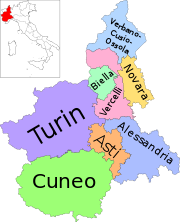Piedmont wine
This article possibly contains original research. (May 2022) |

Piedmont wine is the range of Italian wines made in the region of Piedmont, in the northwestern corner of Italy. The best-known wines from the region include Barolo and Barbaresco. They are made from the Nebbiolo grape. These wines are ideal for storage and a well-aged Barolo for instance may leave a feeling of drinking velvet because the tannins are polished and integrated more and more into the wine. As the wine matures the colour becomes more brownish and rust-red.
Other popular grapes used for red wine production are Barbera and Dolcetto. Wine made with the Barbera grape is often fruity, with high acidity. It can be delicate with less tannin than wine made from the Nebbiolo grape. Dolcetto on the other side, is not, as the name indicates, sweet. Dolcetto means "little sweet one" (dolce is the Italian word for "sweet"). The grape gives fresh and dry red wines with some tannin. The wines made with the Dolcetto grape are typically consumed relatively young.
The
While
History
This section needs additional citations for verification. (May 2022) |
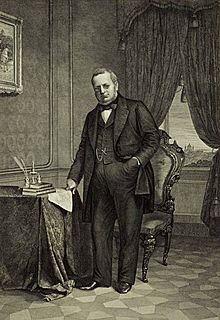
As in most of
During the

One of the early sparks of the Italian
Climate and geography
The Piedmont region is located in the foothills of the
Although the winemaking regions of the Piedmont and
Regions


The majority of the region's winemaking (about 90%) takes place in the southern part of Piedmont around the towns of
The Piemonte wine region is divided into five broad zones.[5]- Canavese – includes the areas around Turin such as Carema and Caluso
- Colline Novaresi – in the province of Novara
- Coste della Sesia – includes the area around Vercelli
- Langhe – includes the hill country around the city of Alba and the Roero.
- Monferrato– includes the areas around Asti and Alessandria
DOCs
The Piedmont region is home to 41 denominazione di origine controllata (DOC) and 19 denominazione di origine controllata e garantita (DOCG).[6][7]
The 19
- Alta Langa
- Asti
- Barbaresco
- Barbera d'Asti
- Barbera del Monferrato Superiore
- Barolo
- Brachetto d'Acqui, also called Acqui
- Ruchè di Castagnole Monferrato
- Canelli
- Cortese di Gavi, also simply called Gavi
- Dolcetto di Dogliani Superiore, also simply called Dogliani
- Dolcetto di Ovada Superiore, also simply called Ovada
- Dolcetto di Diano d'Alba, also simply called Diano d'Alba
- Erbaluce di Caluso, also simply called Caluso
- Gattinara
- Ghemme
- Nizza
- Roero, and Roero Arneis
- Terre Alfieri
Grapes and wines
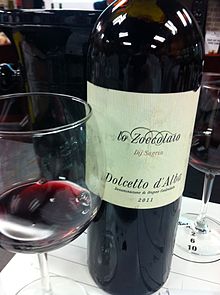
Barbera is the most widely planted grape in the region, but Nebbiolo and Dolcetto account for a significant portion of the area's red wine production as well. With white wines, Moscato is the most prominent with its sparkling and
The Piedmont produces more DOCG wines by volume than any other Italian wine region with nearly 84% of all the areas wine production falling under a DOCG designation. The area has no
Some
Barolo
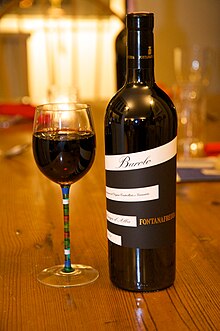
In 1980, the wines of the Barolo region became one of the first Italian wines to receive DOCG status. Produced to the southwest of the town of Alba in the hills of the Langhe, Barolo is a big,
Barbaresco
Being produced from the same grape as Barolo and less than 10 miles apart, there are a lot of similarities that Barbaresco has with it neighboring wines but the slight
Moscato d'Asti
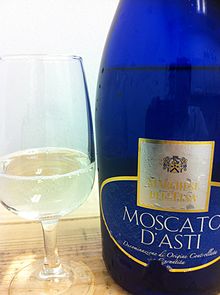
The white wines made from the Moscato Bianco (also known as
Other wines

The Barbera grape is the most widely planted variety in all of the Piedmont and makes a juicy, muscular red wine that is not as tannic as Barolo and Barbaresco. It is grown in nearly every major wine making region of the Piedmont but seems to do best in the southern part of the province of Asti in the Nizza DOCG zone. Some producers are experimenting with blending Barbera with Nebbiolo to combine the former's fruitiness with the later's structure. The light fruitiness of wines from the Dolcetto grape has caused some wine writers to describe it as the Italian version of Beaujolais. The wines have a sense of spiciness to them with little acid and tannins. They are able to be drunk relatively young and tend to be the every day drinking wines of the Piedmontese.[15]
Up until the 1980s, when the wines of the
See also
References
- ^ ISBN 0-671-68702-6.
- ^ ISBN 0-7645-5355-0.
- ^ San Damiano d'Asti climate http://www.weatherbase.com/weather/weather.php3?s=161161&refer=&units=metric
- ^ Bordeaux climate http://www.weatherbase.com/weather/weather.php3?s=1570&refer=&units=metric
- ^ ISBN 0-19-860990-6.
- Denominazione di Origine Controllata e Garantita#Elenco di vini DOCG
- ^ "Vini a Denominazione di origine, DOCG e DOC". Regione Piemonte (in Italian). Retrieved 2024-03-12.
- ISBN 0198600984.
- ISBN 978-1-846-14446-2.
- ISBN 0-7645-5355-0.
- ^ ISBN 0-7645-5355-0.
- ^ ISBN 0-7645-5355-0.
- ISBN 1-56305-434-5.
- ISBN 0-7645-5355-0.
- ^ ISBN 1-56305-434-5.

